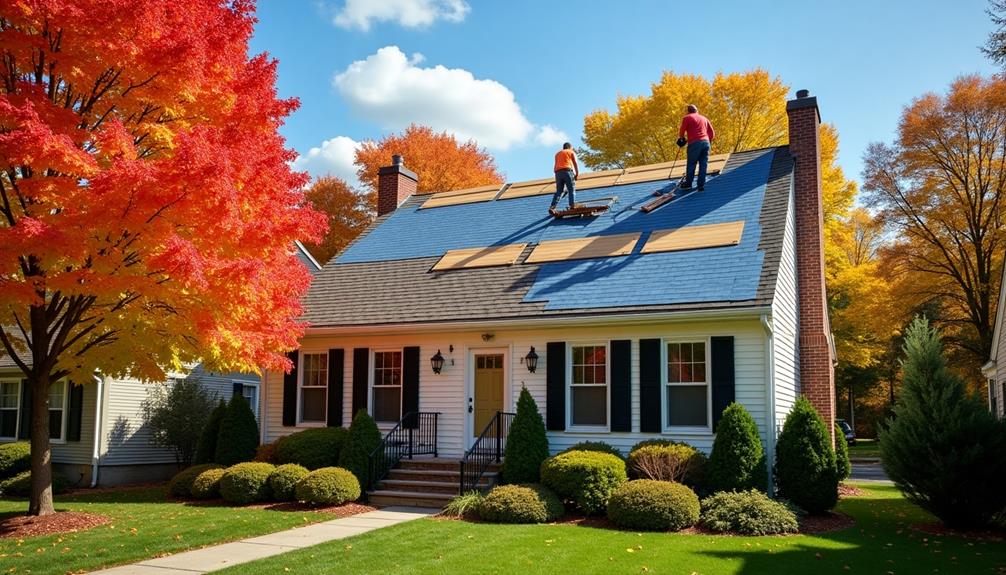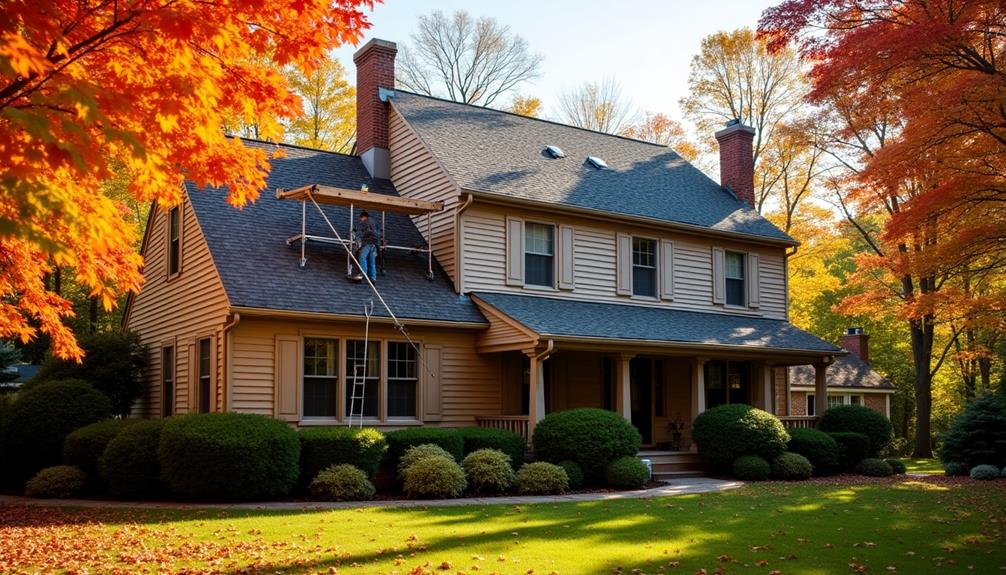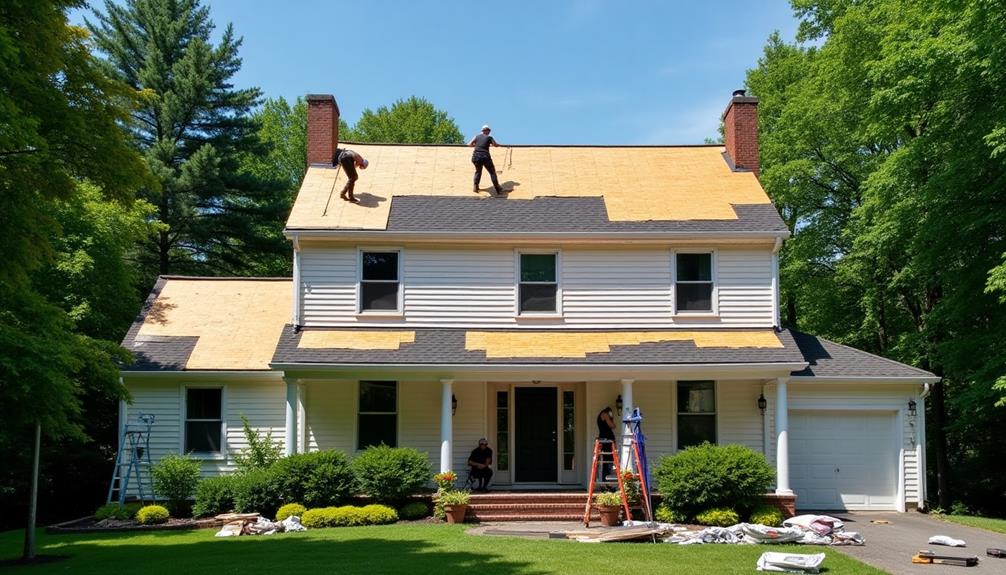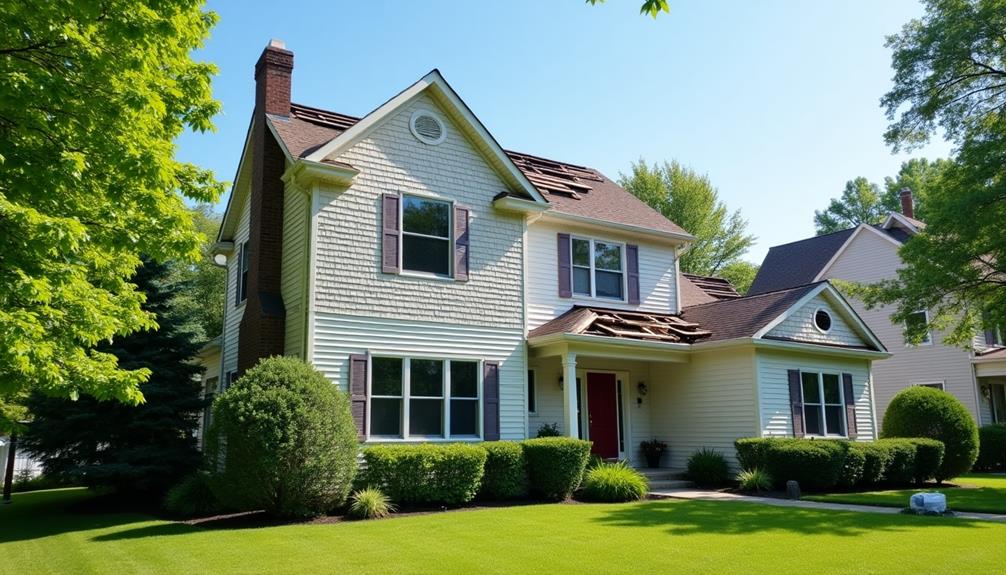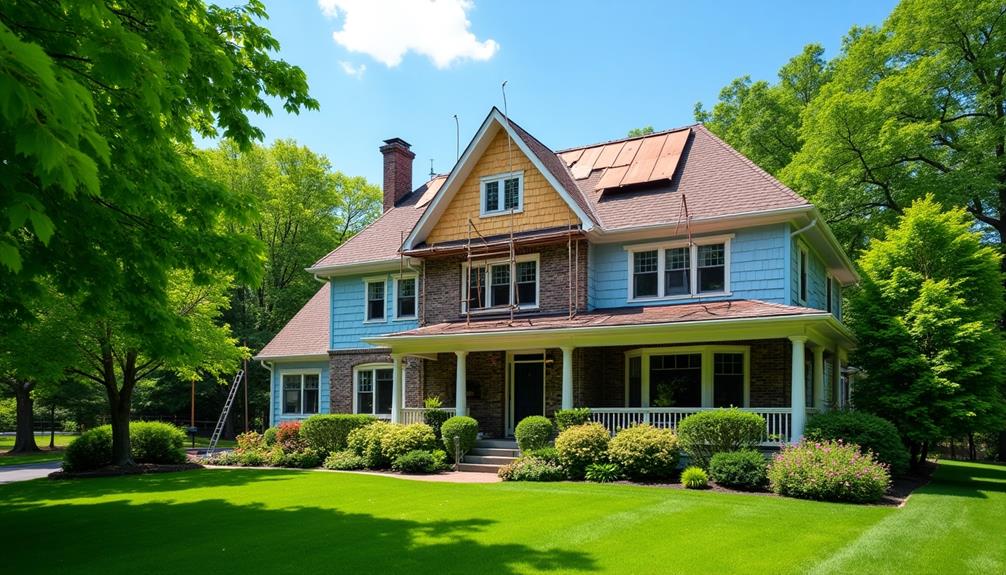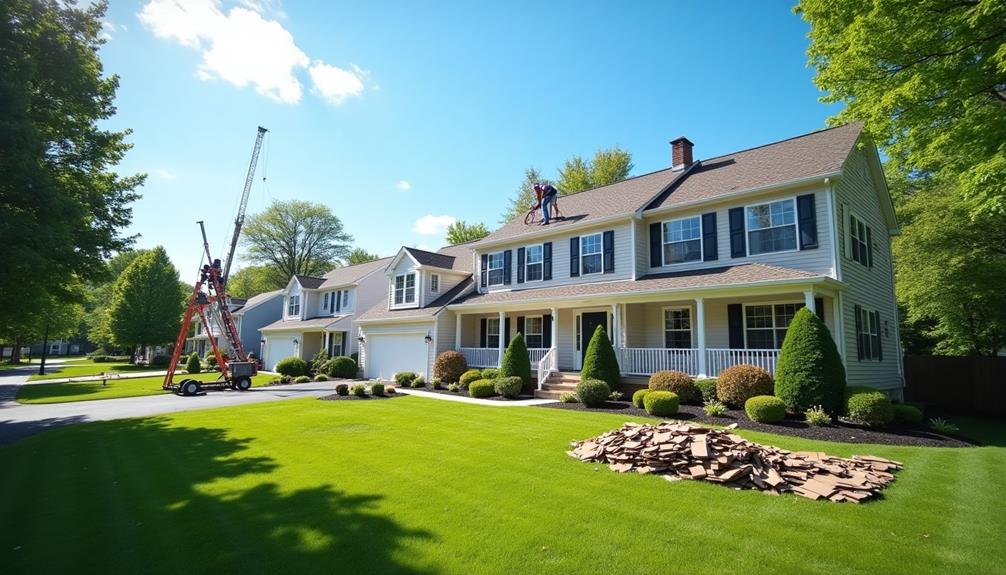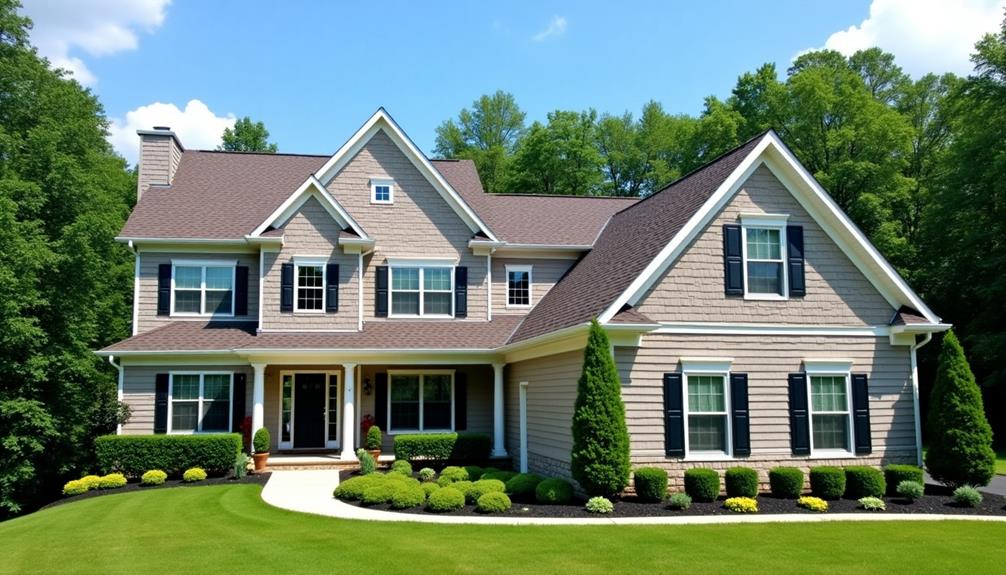If you're considering roof replacement in High Bridge, NJ, it's vital to assess the condition of your roof first. Look for signs of wear, such as missing shingles or water stains. Typically, roofs last between 20 to 30 years, and weather impacts can accelerate their degradation. Various materials, from asphalt to metal, offer different lifespans and benefits. Financially, insurance may cover part of the costs, so review your policy. Choosing a reliable contractor is crucial to ensure quality workmanship. By understanding these key factors, you'll be better prepared for your roofing project. More details will guide you through the process.
Signs You Need a New Roof
When it comes to roof replacement, several clear signs indicate it's time for an upgrade. One of the primary indicators is the age of your roof. Most roofs have a lifespan of 20 to 30 years, depending on the material. If your roof is nearing this age, it's wise to assess its condition closely.
Next, you should watch for visible signs of damage, such as missing or cracked shingles. These issues can compromise your roof's integrity and lead to leaks. Additionally, if you notice sagging in certain areas, it could signify structural problems that require immediate attention.
Weather impacts can also accelerate wear and tear. In areas prone to heavy rainfall, snow, or high winds, your roof may deteriorate faster than expected. Regular inspections after severe weather events can help catch issues early.
Lastly, if you find granules from shingles in your gutters, it's a sign your roof is losing its protective layer. Addressing these signs promptly can save you from more costly repairs down the line, ensuring your home remains safe and sound.
Understanding Roof Replacement Costs
Recognizing the signs that you need a new roof is just the first step; understanding the costs associated with roof replacement is equally important.
Roof replacement costs can vary significantly based on several factors, including the size of your roof, the materials chosen, and any structural repairs needed.
When budgeting for your new roof, consider roofing financing options that may be available to you. Many contractors offer payment plans or financing solutions that can help ease the financial burden.
It's vital to explore these options to find a plan that fits your budget.
Additionally, insurance considerations play a crucial role in your overall expenses. Review your homeowner's insurance policy to determine if roof replacement is covered, and consult with your insurance agent to understand potential claims processes.
If your roof was damaged due to a covered event, your insurer might help offset some of the costs, making the replacement more affordable.
Types of Roofing Materials
Choosing the right roofing material is crucial for ensuring the longevity and performance of your new roof. Various options are available, each with unique characteristics, benefits, and drawbacks. It's essential to understand these options to make an informed decision.
Here's a quick comparison of popular roofing materials:
| Material | Lifespan | Eco-Friendly Option |
|---|---|---|
| Asphalt Shingles | 15-30 years | Limited |
| Metal Roofing | 40-70 years | Yes |
| Wood Shingles | 20-30 years | Yes (sustainably sourced) |
| Slate | 50+ years | Yes |
| Tile | 50+ years | Yes |
Metal roofing is gaining popularity due to its durability and energy efficiency, making it a strong contender for homeowners. Additionally, eco-friendly options like sustainably sourced wood and certain tile materials can help reduce your environmental impact while providing excellent protection for your home.
When selecting a roofing material, consider factors such as climate, budget, and maintenance requirements. Understanding these elements will empower you to choose the best roofing solution for your needs in High Bridge, NJ.
Benefits of Roof Replacement
Replacing your roof offers numerous benefits that can significantly enhance your home's value and performance. One of the most important advantages is improved energy efficiency. A new roof with modern insulation and reflective materials can reduce heat absorption, keeping your home cooler in the summer and warmer in the winter. This not only lowers your energy bills but also contributes to a more comfortable living environment.
Additionally, a roof replacement can dramatically boost your home's curb appeal. A fresh, well-installed roof enhances the overall aesthetic of your property, making it more attractive to potential buyers if you ever decide to sell. Homes with updated roofs often fetch higher resale values, making this investment worthwhile.
Moreover, a new roof is less likely to develop leaks or require frequent repairs, which saves you money in the long run. You'll also gain peace of mind knowing that your home is protected from the elements.
Choosing the Right Contractor
When it comes to roof replacement, selecting the right contractor is crucial to ensuring a successful project. Start by verifying contractor credentials. Look for licenses, insurance, and certifications that demonstrate their expertise and commitment to quality. A qualified contractor should have a solid track record in the industry, so ask for references or check online reviews.
Next, discuss the project timeline with potential contractors. A reputable contractor will provide a clear outline of the expected duration of the project, including any potential delays due to weather or material availability. This will help you set realistic expectations and plan accordingly.
Don't hesitate to ask detailed questions about their process, materials used, and warranty options. A contractor who's transparent about their methods and willing to address your concerns is likely to provide a better experience.
Preparing for Roof Replacement
Before starting your roof replacement, it's essential to assess the current condition of your roof to identify any underlying issues.
Choosing quality materials won't only enhance durability but also improve the overall aesthetics of your home.
Proper preparation sets the foundation for a successful roofing project, ensuring you make informed decisions every step of the way.
Assessing Roof Condition
To ensure a successful roof replacement, you must first assess the current condition of your roof.
Begin by inspecting for visible signs of damage, such as missing shingles, cracks, or sagging areas. These indicators can significantly affect your roof's lifespan.
Next, consider the age of your roof. Typically, roofs last between 20 to 30 years, depending on the materials used and the local weather impact.
Pay attention to leaks or water stains in your attic, as these can suggest underlying issues that need addressing.
Additionally, examine the flashing around chimneys and vents, as improper sealing can lead to moisture intrusion.
Don't forget about the gutters; ensure they're clear of debris, as clogged gutters can cause water to back up and damage your roof.
If you're unsure about your assessment, it's wise to consult a professional roofing contractor.
They can provide a thorough evaluation and recommend necessary repairs or a complete replacement.
Choosing Quality Materials
Once you've assessed your roof's condition and determined that a replacement is necessary, the next step involves selecting quality materials that will enhance durability and performance.
Choosing the right materials is crucial for ensuring your new roof can withstand the elements and provide long-lasting protection for your home.
Start by researching various roofing materials, such as asphalt shingles, metal, or slate. Each option has its own advantages in terms of material longevity and aesthetic appeal.
Asphalt shingles are cost-effective and versatile, while metal roofs offer exceptional durability and energy efficiency. Slate, though more expensive, can last over a century, making it a worthwhile investment.
Don't forget to consider roofing warranties. A comprehensive warranty not only protects your investment but also reflects the manufacturer's confidence in their product's longevity.
When selecting materials, verify the warranty terms and coverage details, including labor and potential defects.
Ultimately, investing time in choosing high-quality materials will pay off in the long run, reducing the need for frequent repairs and replacements.
Maintaining Your New Roof
To ensure your new roof remains in optimal condition, it's crucial to establish a regular inspection schedule.
Cleaning your gutters and drains will prevent water buildup that can lead to damage, while addressing any repairs promptly will extend the life of your roof.
Regular Inspections Schedule
Regular inspections are crucial for maintaining the integrity and longevity of your new roof. Establishing a regular inspection schedule allows you to identify potential issues before they escalate into costly repairs. It's recommended to conduct inspections at least twice a year, ideally in the spring and fall. This inspection frequency helps you catch any damage caused by harsh weather conditions or debris accumulation.
During these seasonal checkups, focus on critical areas such as flashing, shingles, and gutters. Look for signs of wear, such as cracked or missing shingles, which can compromise your roof's protective barrier. Pay attention to the condition of the flashing around chimneys and vents, as this is a common area for leaks to develop.
Additionally, inspect for any signs of mold or mildew, which can indicate moisture issues. Don't forget to assess the attic for proper ventilation and insulation, as these factors directly impact your roof's performance.
Clean Gutters and Drains
Maintaining clean gutters and drains is essential for protecting your new roof from water damage and ensuring proper drainage. Clogged gutters can lead to water overflow, which may damage your roof, walls, and foundation.
Regular gutter maintenance is crucial; you should inspect and clean your gutters at least twice a year, ideally in the spring and fall. This helps prevent debris buildup, such as leaves and twigs, that can obstruct water flow.
When cleaning your gutters, ensure you remove all debris and check for any signs of damage, such as rust or cracks. If you find any issues, address them immediately to avoid further complications.
Additionally, don't forget about drain cleaning. Ensure downspouts direct water away from your home's foundation, and clear any blockages that could impede water flow.
Consider installing gutter guards to minimize debris accumulation and reduce the frequency of maintenance tasks.
Address Repairs Promptly
After ensuring your gutters and drains are clean, addressing repairs promptly is vital for maintaining your new roof's integrity.
Regular inspections will help you identify issues early, preventing small problems from escalating into costly emergency repairs. If you notice any missing shingles, leaks, or damage, don't wait—schedule repairs immediately.
Establishing a repair timeline is essential. Ideally, you should assess your roof at least twice a year and after severe weather events. This proactive approach allows you to keep your roof in optimal condition and extend its lifespan.
When you detect a problem, document it and contact a qualified roofing professional to evaluate the damage and recommend a solution.
Ignoring minor repairs can lead to more significant issues, such as structural damage or mold growth, which could compromise your home's safety and value.
By prioritizing repairs and adhering to a repair timeline, you'll not only enhance your roof's performance but also safeguard your investment.
Local Building Regulations in NJ
Navigating local building regulations in New Jersey is crucial for homeowners planning a roof replacement. Understanding local permits, zoning laws, and safety regulations will ensure your project complies with state and local codes. Before starting, you'll need to confirm that your contractor holds the necessary licensing and adheres to inspection requirements.
Here's a helpful table summarizing key considerations:
| Aspect | Description | Importance |
|---|---|---|
| Local Permits | Required approvals from local authorities | Ensures compliance with law |
| Zoning Laws | Regulations that dictate building types and placements | Prevents legal disputes |
| Safety Regulations | Guidelines to ensure worker and public safety | Protects everyone on-site |
| Building Codes | Standards for construction and materials used | Guarantees quality and durability |
| Environmental Considerations | Requirements for minimizing ecological impact | Promotes sustainability |
Also, if your home is in a historical district, you'll need to pay attention to historical preservation regulations. Adhering to these rules not only keeps your project on track but also protects your investment. Always consult with local authorities to stay informed and compliant.

